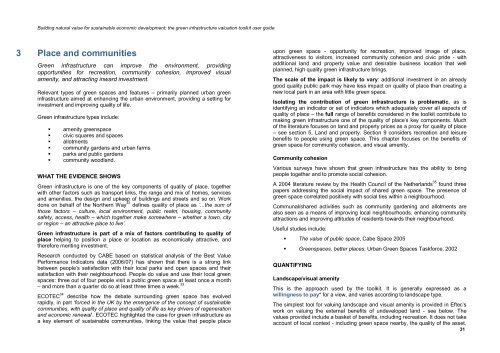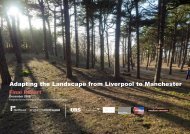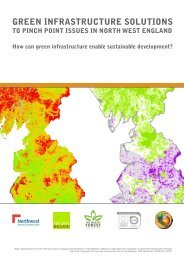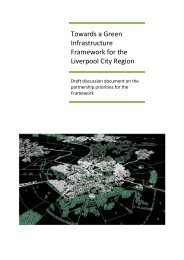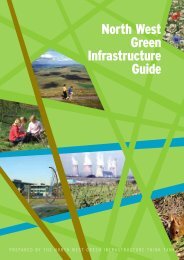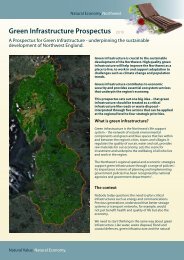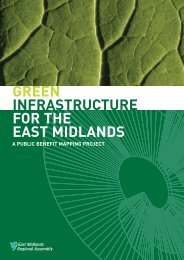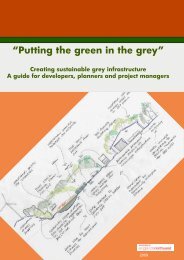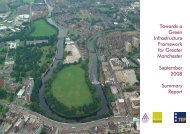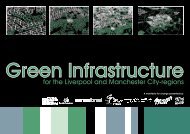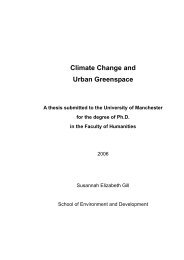The green infrastructure valuation toolkit user guide
The green infrastructure valuation toolkit user guide
The green infrastructure valuation toolkit user guide
Create successful ePaper yourself
Turn your PDF publications into a flip-book with our unique Google optimized e-Paper software.
Building natural value for sustainable economic development: the <strong>green</strong> <strong>infrastructure</strong> <strong>valuation</strong> <strong>toolkit</strong> <strong>user</strong> <strong>guide</strong><br />
3 Place and communities<br />
Green <strong>infrastructure</strong> can improve the environment, providing<br />
opportunities for recreation, community cohesion, improved visual<br />
amenity, and attracting inward investment.<br />
Relevant types of <strong>green</strong> spaces and features – primarily planned urban <strong>green</strong><br />
<strong>infrastructure</strong> aimed at enhancing the urban environment, providing a setting for<br />
investment and improving quality of life.<br />
Green <strong>infrastructure</strong> types include:<br />
<br />
<br />
<br />
<br />
<br />
<br />
amenity <strong>green</strong>space<br />
civic squares and spaces<br />
allotments<br />
community gardens and urban farms<br />
parks and public gardens<br />
community woodland.<br />
WHAT THE EVIDENCE SHOWS<br />
Green <strong>infrastructure</strong> is one of the key components of quality of place, together<br />
with other factors such as transport links, the range and mix of homes, services<br />
and amenities, the design and upkeep of buildings and streets and so on. Work<br />
done on behalf of the Northern Way 32 defines quality of place as ‘...the sum of<br />
those factors – culture, local environment, public realm, housing, community<br />
safety, access, health – which together make somewhere – whether a town, city<br />
or region – an attractive place to live’.<br />
Green <strong>infrastructure</strong> is part of a mix of factors contributing to quality of<br />
place helping to position a place or location as economically attractive, and<br />
therefore meriting investment.<br />
Research conducted by CABE based on statistical analysis of the Best Value<br />
Performance Indicators data (2006/07) has shown that there is a strong link<br />
between people’s satisfaction with their local parks and open spaces and their<br />
satisfaction with their neighbourhood. People do value and use their local <strong>green</strong><br />
spaces: three out of four people visit a public <strong>green</strong> space at least once a month<br />
– and more than a quarter do so at least three times a week. 33<br />
ECOTEC 34 describe how the debate surrounding <strong>green</strong> space has evolved<br />
rapidly, in part ‘forced in the UK by the emergence of the concept of sustainable<br />
communities, with quality of place and quality of life as key drivers of regeneration<br />
and economic renewal’. ECOTEC highlighted the case for <strong>green</strong> <strong>infrastructure</strong> as<br />
a key element of sustainable communities, linking the value that people place<br />
upon <strong>green</strong> space - opportunity for recreation, improved image of place,<br />
attractiveness to visitors, increased community cohesion and civic pride - with<br />
additional land and property value and desirable business location that well<br />
planned, high quality <strong>green</strong> <strong>infrastructure</strong> brings.<br />
<strong>The</strong> scale of the impact is likely to vary: additional investment in an already<br />
good quality public park may have less impact on quality of place than creating a<br />
new local park in an area with little <strong>green</strong> space.<br />
Isolating the contribution of <strong>green</strong> <strong>infrastructure</strong> is problematic, as is<br />
identifying an indicator or set of indicators which adequately cover all aspects of<br />
quality of place – the full range of benefits considered in the <strong>toolkit</strong> contribute to<br />
making <strong>green</strong> <strong>infrastructure</strong> one of the quality of place’s key components. Much<br />
of the literature focuses on land and property prices as a proxy for quality of place<br />
– see section 5, Land and property. Section 9 considers recreation and leisure<br />
benefits to people using <strong>green</strong> space. This chapter focuses on the benefits of<br />
<strong>green</strong> space for community cohesion, and visual amenity.<br />
Community cohesion<br />
Various surveys have shown that <strong>green</strong> <strong>infrastructure</strong> has the ability to bring<br />
people together and to promote social cohesion.<br />
A 2004 literature review by the Health Council of the Netherlands 35 found three<br />
papers addressing the social impact of shared <strong>green</strong> space. <strong>The</strong> presence of<br />
<strong>green</strong> space correlated positively with social ties within a neighbourhood.<br />
Communal/shared activities such as community gardening and allotments are<br />
also seen as a means of improving local neighbourhoods, enhancing community<br />
attractions and improving attitudes of residents towards their neighbourhood.<br />
Useful studies include:<br />
<strong>The</strong> value of public space, Cabe Space 2005<br />
Greenspaces, better places, Urban Green Spaces Taskforce, 2002<br />
QUANTIFYING<br />
Landscape/visual amenity<br />
This is the approach used by the <strong>toolkit</strong>. It is generally expressed as a<br />
willingness to pay* for a view, and varies according to landscape type.<br />
<strong>The</strong> simplest tool for valuing landscape and visual amenity is provided in Eftec’s<br />
work on valuing the external benefits of undeveloped land - see below. <strong>The</strong><br />
values provided include a basket of benefits, including recreation. It does not take<br />
account of local context - including <strong>green</strong> space nearby, the quality of the asset,<br />
31


